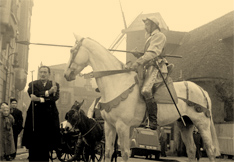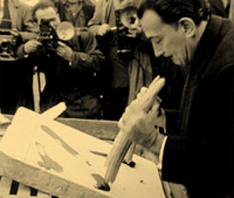The end of the 19th century saw Montmartre to be the center of artistic life, with Toulouse-Lautrec (Au Moulin Rouge, 1891), Renoir (Bal du Moulin de la Galette, 1876), and Picasso (Les Demoiselles d’Avignon, 1907). Artist workshops began to flourish like the famous “Bateau Lavoir” (1907) where cubism was born.
Dalí came to live at 7, rue Becquerel, in the apartment that Paul Eluard found in 1929 for Gala.
He couldn’t miss seing the windmills, an essential aspect of the Montmartre myth and of Certvantes’ Don Quixote, Knight errant, which he wanted to illustrate.

In November 1956, Dalí undertook “to produce the first engravings of the Don Quixote series before the press, in the Place Jean Baptiste Clément. The master used two [rhinoceros] horns and some bread dipped in ink in the process. A short film was made to immortalize the scene. It was “to illustrate paranoically all the electric mystery of the liturgy of this scene and the moral character of the audience”.

After the second world war, Maurice Utrillo’s widow, the flamboyant Lucie Valore, the self-proclaimed Empress of Montmartre, suggested to Dalí the he became the Emperor of Montmartre ; Dalí was charmed and accepted, but the affair did not prosper.